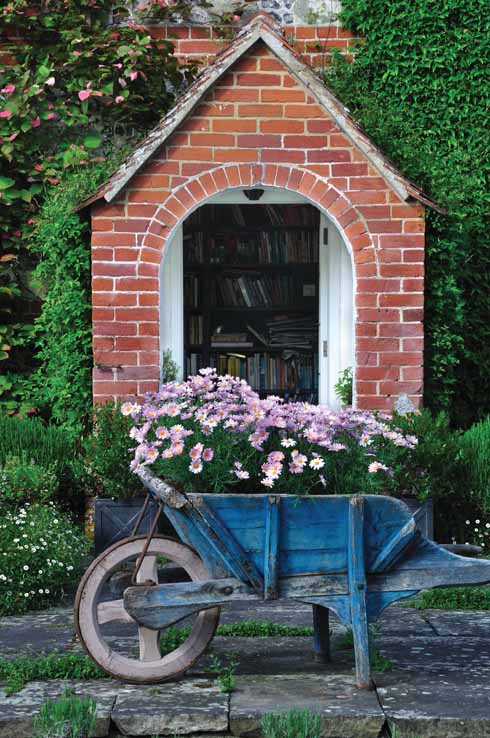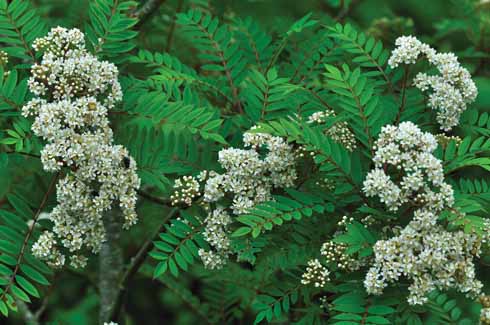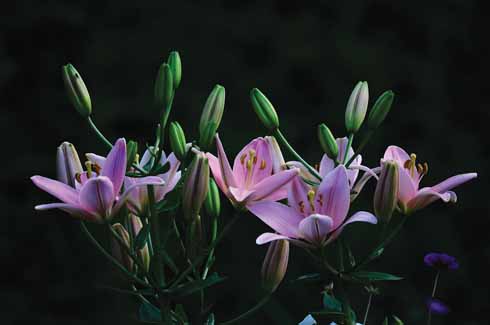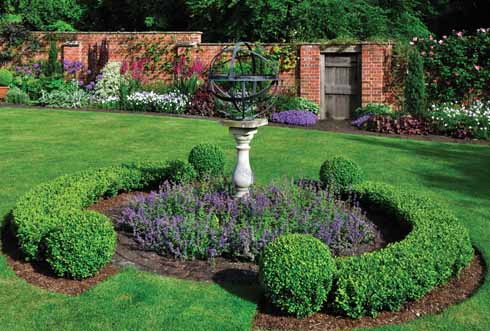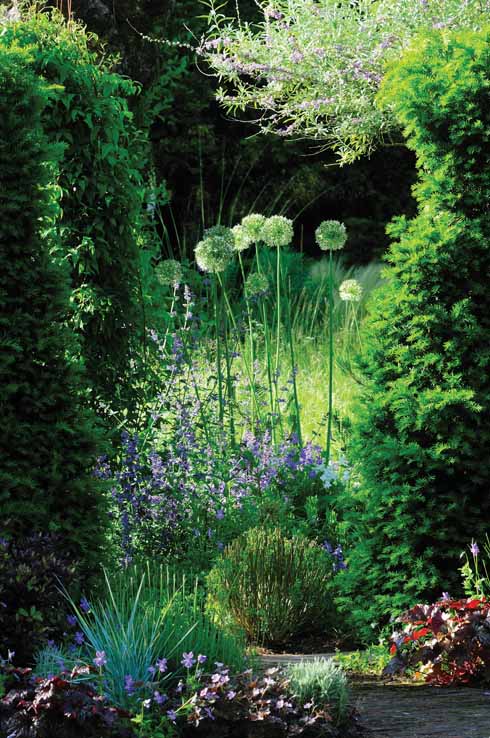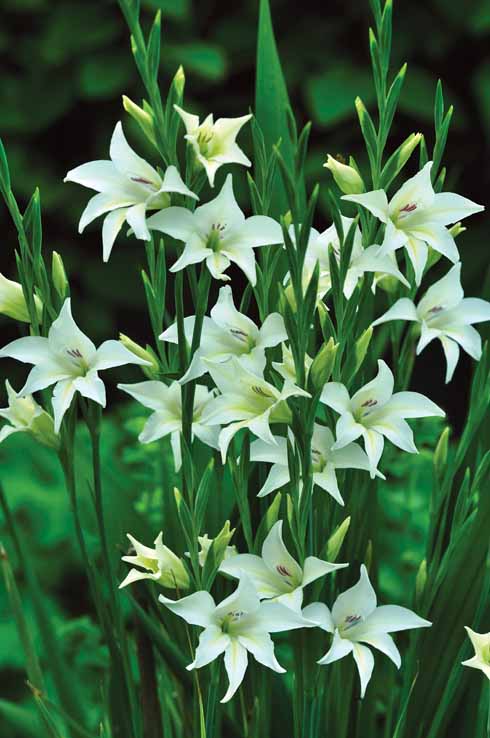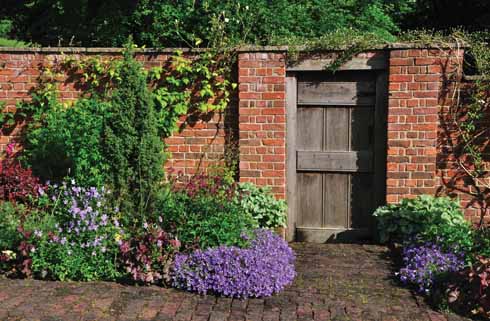A Dorset Garden – Cottage Row
Colin and Susy Varndell in the first of this month's two visits to Tarrant Gunville
Published in July ’15
Tarrant Gunville is situated in the valley of the River Tarrant. The gentle meanderings of both the road and the river, with a few thatched cottages strewn along their way, create an idyllic rural setting. Up a narrow lane is Cottage Row, an unassuming cottage from the road but quite magical once you have entered.

Stipa giganticea, or golden oats, has large arching stems which ripen to a lovely golden colour in the autumn
The garden itself is half an acre adjoining a delightful and typical Dorset flint and red brick cottage. It is partly walled and is full of the most interesting and varied views and vistas as well as beautiful plants. The specially selected plants enhance the hard structures, which are the backbone of the garden. Yew hedges and pergolas separate various parts of the garden, formal and informal, and brick paths lead you through to each distinct feature including an arbour, a tree house, a water garden and a kitchen garden.

From the York stone terrace in front of the house a brick path leads down past a colourful mixed border
The owners, Carolyn and Michael Pawson, moved here about ten years ago and as there was no garden to speak of they had to start from scratch. They did inherit the beautiful York stone terrace in front of the cottage, but this had to be re-laid. Everything else is their creation, even the lovely brick wall with its enchanting door, which looks as though it has been there for centuries. This is essentially a cottage garden, but a tad more sophisticated, as the owners do enjoy unusual plants. The inspiration for the garden has come from both Russell Page’s The Education of a Gardener and Christopher Lloyd, both of whom Carolyn regards as being her mentors. Otherwise she considers herself to be self-taught relying on her background in painting and sculpting to aid her design decisions in relation to form, structures, textures and colour.
The garden has been planned with flowers and foliage in the grey, blue and mauve side of the spectrum. But as the grey leaves keep disappearing due to frosts (being mostly Mediterranean plants) it is an area which Carolyn wants to improve further and develop.
Visitors to the garden enter through a charming door in the brick, west-facing wall. On entering this ‘Secret Garden’ you are overcome with a wealth of features making it difficult to take it all in at once. The lovely cottage is on one’s right with its terrace in front. There are brick paths leading all over the place, and there is a strange, but beautiful looking object in the middle of the lawn which begs investigation. One’s eyes are led down different avenues with interesting objects at each of their destinations, all of which demand to be admired and investigated.
The armillary, a sphere in the middle of the lawn, is an ancient device for representing the geometry of the earth and solar system, used in the study of astronomy, geography and navigation. Essentially an armillary is similar to a sundial for they both tell the time. This armillary is surrounded by a neat box hedge, symmetrical in essence, giving the appearance of a parterre. Look out for the carefully selected wording asking, ‘What are days for? Days are where we live’ exhorting one to stay and enjoy the present as everything is ephemeral. If you look past the armillary and through the arch you will see a bench. Every view has something to aim for, a full stop at the end of each path, a satisfying conclusion.
As you wander around the garden enjoying all the paths and views so carefully created you will also become aware of the thoughtful use of plants. The hard structures and shapes are surrounded with plants that love to create their own space, softening the hard edges with their shape and colour and, according to Carolyn, preferably with something which lasts and lasts, like catmint. Not only does catmint flower continuously for weeks, but it is also loved by the bees, an important ingredient of this cottage garden. Alliums, also loved by bees, are another feature of this garden as are clematis. These are grown in and around everything. Some shrubs, which flower early in the year, have clematis scrambling through them later on in the summer, ensuring that no space is wasted or only used once. In addition to the clematis, specimen roses adorn most of the walls. Each one has been chosen for a specific reason ensuring the scent, flowers and hips enrich each location accordingly.

This rose is a strong growing shrub with thorny stems; it produces a good crop of hips in the autumn

Clematis etoile rose flowers in abundance for a long season and has beautiful bell-shaped red-pink flowers
The metal arbour has a Viburnum plicatum trained up it, which smells wonderful, but as it is over in April, later in the year it is then smothered in Clematis Little Nell and Betty Corning, which are both examples of viticella clematis. Underneath this metal arbour is a wonderful wooden bench, or seat, made of cedar wood with the legs made of oak. On the front of the seat is inscribed ‘circumspice,’ a quote taken from Sir Christopher Wren’s memorial in St Paul’s Cathedral: ‘[Reader, if you seek his monument,] look around you’.
The lavender in front of the house and edging the terrace is Lavandula x intermedia Lullingstone Castle. This lavender prefers light free-draining soil in a sunny position so it is in the perfect place to flourish. It is cut back hard after flowering to maintain its shape and it looks good throughout the winter. Another advantage of planting this lavender is that the bees and moths love it. One disadvantage of this plant is that it is short lived so needs replacing every three or four years.
Although the garden is full of amazing and interesting plants the owners permit no pesticides or slug pellets to be used, preferring instead for the natural world to take care of any pests, which indeed it appears to do exceedingly successfully. The natural balance within the garden is therefore maintained and the wildlife in the garden is not in danger, it is welcomed. ◗
